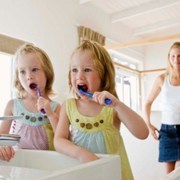 Photo: Getty Images
Photo: Getty Images
Healthy gums, clean teeth, and preventative dentistry translate into healthy mouths and better overall health for children. The American Academy of Pediatric Dentistry (AAPD) reminds us that improper oral conditions can interfere with a child’s speech, self-esteem, nutrition, and classroom focus.
Preventative dentistry, on the other hand, can reduce cavities, maintain gum and tooth health, and mean less expensive treatments for your child.
According to AAPD, preventative dentistry includes both regular dental check-ups and daily dental care at home. During regular dental check-ups, your dentist and hygienist will provide fluoride treatments to strengthen teeth, check for developing cavities, and professionally clean and polish teeth for a healthy smile.
A child’s first regular dental check-up trip can be scheduled as soon as a parent spies the first tooth in a child’s mouth, and no later than a child’s first birthday. As your child grows, AAPD explains that preventative dentistry can include sealants to protect permanent molars from decay and orthodontia recommendations.
The American Dental Association (ADA) reports that a child’s baby teeth, or primary teeth, first erupt around 6 months of age. Generally, a child’s two upper and two lower teeth appear first, with the full set of primary teeth appearing by about age 3.
The primary teeth help a child chew and speak, as well as hold a place in the gum while the adult teeth form. Around age 6, a child will begin to lose his or her baby teeth as the permanent teeth emerge.
ADA recommends brushing a child’s teeth with a damp brush, as soon as they appear. Consult a dentist before using toothpaste on a child under the age of 2. At 2 years, a child can begin to brush, with adult supervision, using a pea-sized glob of toothpaste on his or her toothbrush.
Teach children to spit and rinse afterwards with water. Discourage children from swallowing any toothpaste.
ADA says that by age 6 or 7, kids should be able to brush on their own, twice a day. Flossing, important to healthy gums, can begin as soon as two teeth are touching.
Ask your dentist or hygienist to demonstrate the best way to floss your child’s teeth. Consult with your family dentist and encourage proper nutrition and brushing and flossing habits to ensure your child has a healthy smile.
Sources:
American Academy of Pediatric Dentists. Preventative Dentistry. Web. 28, Nov. 2011.
http://www.aapd.org/publications/brochures/preventdent.asp
American Dental Association. Baby’s First Teeth. Web. 28, Nov. 2011.
http://www.ada.org/sections/publicResources/pdfs/patient_11.pdf
Reviewed November 29, 2011
by Michele Blacksberg RN
Edited by Jody Smith




Add a Comment1 Comments
Parents really need to make oral/dental health a priority for children. It is something most follow thru with all their lives when parents place an importance on it. In the long run you actually save money by going for regular checkups vs only emergency visits. Maintaining good dental health should be important your entire life.
Marielaina Perrone DDS
October 17, 2012 - 11:00amHenderson Family Dentist
This Comment